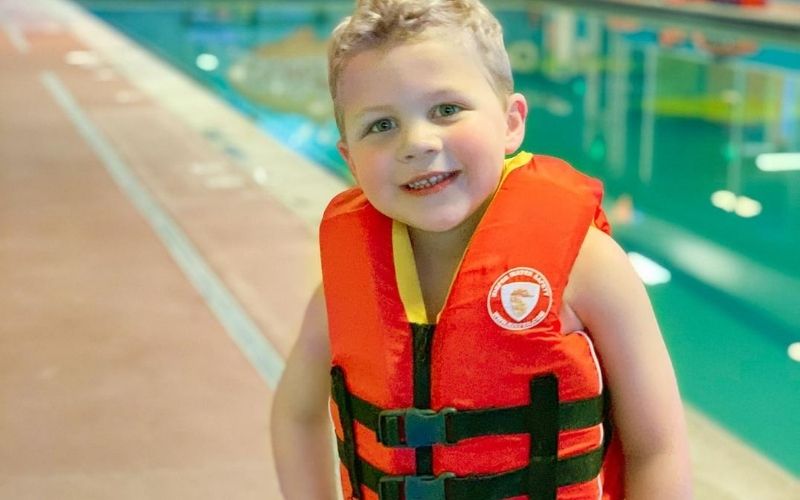Drowning Rates in Lake Michigan are Up and Pools can be Just as Dangerous. Teach Water Safety for Kids Today.
Swimming is one of the best summer things to do around Grand Rapids. Whether it’s Lake Michigan, an inland lake or a local pool.
That’s why it’s essential that we teach water safety for kids. Last year, 45 people drowned in Lake Michigan, many of which were on the West Michigan coast.
Drowning is also the number one cause of injury-related death among kids ages 1-4. It’s the second leading cause of death for kids ages 5-14.
Drownings don’t just happen at the beach or a pool, either. Bathtubs, toilets, buckets of water, and kiddie pools are all potential drowning hazards.
According to Goldfish Swim School, “before the pandemic, 90% of child drowning deaths occurred when a caregiver was supervising, and 77% of drowning victims had only been out of sight for less than five minutes.”
These stats make the rest of this article really, really important.
Can you Drown-Proof Your Kids?
Michigan Summer = Water = Swimming
You’ve heard it said a million times: we live in Michigan, there is water all around us.
And if you live here, you know the glory that is a Michigan summer. While we’re planning trips to parks and beaches, something that should be on everyone’s mind is water safety for kids.
As an adult, you probably know how to be safe around the water. But do your kids? You might think they know, but do they really?
NOW is the time to talk to your kids about water safety.
Michigan is the Great Lake State, after all. So how can we allow our kids to enjoy our natural resources without letting fear of water-related incidences overwhelm us?
Can we really drown-proof our kids? Let’s find out.

How to Make Swimming Time Fun AND Safe
The American Academy of Pediatrics (AAP) wants swimming to be a fun and safe family activity.
We have all heard the scary statistics: drowning is the leading cause of injury deaths in children ages 1-4 years old. The AAP set out new water safety for kids guidelines so you can have a great summer.
This means, unfortunately, you can’t just “drown-proof” your children. You can, however, surround them with “layers of protection” and work on DROWNING PREVENTION.
Short story: there isn’t just one way to prepare. Read on for the best tips for water safety from the AAP and Goldfish Swim School, plus a bonus Kid Quiz.
Get Your Kiddos Swimming Regularly!
First and foremost: enroll your kids in swim lessons!
This should be a year-round practice, not just a “tune-up.” Like with learning an instrument, practice makes us better. While your kiddos are learning the swim basics, you should educate yourself on water safety for kids to eliminate drowning.
The AAP Website has some fantastic resources.
Goldfish Swim School can also help educate, by offering a free water education program for classrooms, mom groups, and more. Goldfish is a designated Drowning Prevention facility.
Once you have that info, moms and dads, you should consider learning CPR and designate yourself as the water guardian.
Keep eyeballs on swimming kids! You’re the first line of defense – you’re only watching your kids, while a lifeguard may be watching twenty times that.
And don’t forget — drowning can happen anywhere there is at least a bucket of water, so create barriers around pools and even bathtubs.

Pool at Home? Here’s What to Watch Out For
It may seem harmless enough to leave pool toys in the pool — that’s what they’re for, right?
But if your kids are like mine, they zero in on anything remotely fun.
Don’t store toys in the pool; you don’t want to attract any little ones.
Instead, consider pool and door alarms.

These features will help you know when your kiddos may be headed somewhere they shouldn’t be. And don’t forget to keep those alarms in good working order.
When you are out swimming, make sure all of your children are wearing Coast Guard-approved Life Jackets.
Pool noodles or swimmies will NOT prevent drowning.
Even if they have Paw Patrol on them. Even if your kids love them. Treat them like the toys they are — not water safety devices.

My Kids are Older — This Isn’t Aimed at Me, Right?
This information is for kids of all ages… Adolescents have the second-highest fatal drowning rate.

Even “strong swimmers” can learn a lot by completing lifeguard classes. Teens don’t have to become lifeguards to benefit from these classes.
Just being aware of dangers and precautions is invaluable – and can help them overcome the “I’m invincible” phase that many teens go through.

Last, but not least, go over the water rules.
Do this every time you play in the water — make sure everyone is on the same page. These layers of protection will help your children stay safe and provide you with some peace of mind. Vigilance is important, but don’t forget to have fun!
Goldfish Swim School has provided us with a Quick Quiz that you can give your kids NOW to see how much water safety for kids knowledge they have.
Note: Even if a child does well on this quiz, s/he still needs constant supervision while around any sort of water feature.
How Water-Smart Is Your Child Right Now?
Give this quick quiz to your kid to find out.
Q1: (for little kids) Do you ever swim alone?
No. Only swim when a grownup is with you. Even adults should swim together.
Q2: (for little kids) What should you always wear when you’re on a boat?
A life jacket. (And make sure it is Coast Guard approved!)
Q3: Who should be with you when you go swimming?
An adult. Only go swimming with mom, dad, or when a trusted adult is with you.
Q4: Why are there fences/gates around pools?
To keep people safe. Fences and gates keep kids and people from accidentally getting close to a pool and falling in when there’s no one around to help them get out.
Q5: What do you do if you see someone struggling to swim?
Call for help. Do not jump in. Throw them something that floats or run and get an adult to help.
Q6: What should you do if you fall into the water?
Turn around and grab the wall/dock.
Q7: Why aren’t you allowed to run on a pool deck?
You can fall onto the deck or into the water and and hurt yourself and others.
Q8: If your toys float away, what should you do?
Never go after a toy. Ask an adult for help instead.
Q9: Should you push or jump on friends in the pool?
No. It could hurt them.
Reminders to Parents on Water Safety for Kids
Number one rule for parents:
Never leave a child alone near any water for even a second. This means bathtubs, toilets, buckets or water etc.
Safety actions you can take at home:
- Keep the lid on all toilets.
- Don’t leave any standing water around the house. Drain/dump all water after use (bathtubs, buckets, baby pools etc).
- Make sure pools, hot-tubs and ponds have the proper safety fences, covers, nets and locks on them.
- Even if there is a lifeguard on duty you should still keep an eye on your children. A lifeguard’s job is to watch all the children. Think of them as an extra set of eyes for you. Remember that you are the best person to watch out for your child.
- Not all bodies of water are the same. Make sure to explain the differences to your children. You should discuss: temperature, depth, clarity, and movement of the water.
- Due to changes in the swimming conditions a child may not swim as well as they do in class.
- Be extra careful around moving water. It is always important to explain to your children how waves, currents and safety zones work.
- It is always best to put a life jacket on children when they are swimming in moving bodies of water (oceans, rivers, creeks, and hot tubs).
- Make sure floatation devices are Coast Guard approved.
- If you have a home pool make sure that you put a STOP sign at the gate entrance at the child’s eye level. This will help the children understand that they are not allowed to open this gate only adults are allowed in.
- Pool rules should be both written and have pictures to help children of all ages understand what is expected when they are using the facility.

Fun Goldfish Activities
Goldfish has put together a resource page of activities you can do at home with your kids.
The water safety for kids crossword puzzle below is one of the things you’ll find there. Click the image to download your own copy.

Goldfish Swim School
Featured Partner
2845 Thornhills Ave., Ste S Grand Rapids, MI 49546


